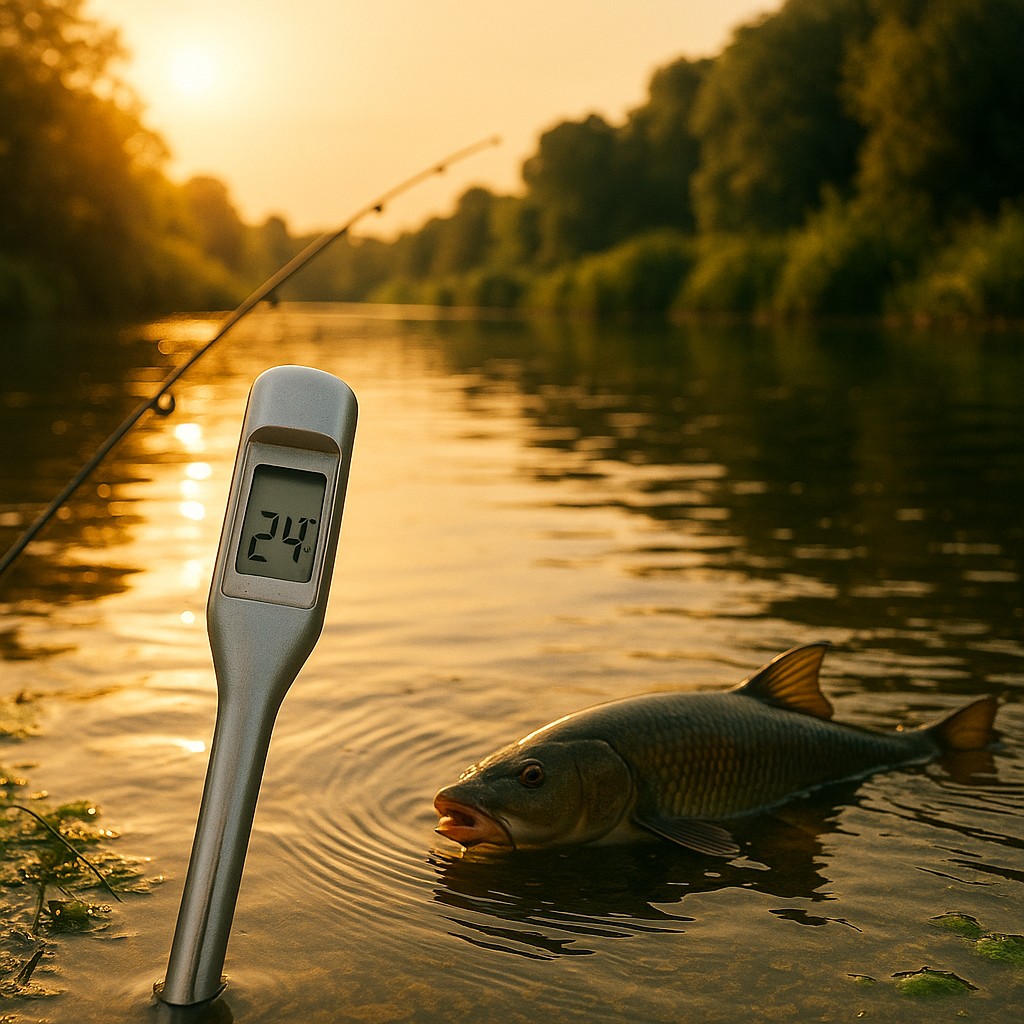This summer’s been brutal for British rivers. If you’ve been wondering why your local stretch looks like green soup or why fish seem completely off the feed, you’re not alone. June 2025 broke records we didn’t want to break – the River Wye hit 25.3°C, and the Environment Agency logged 87 fish kill incidents in just three weeks.
As anglers, we’re facing a new reality. Those lazy summer evening sessions might need rethinking when the water’s running hotter than your morning coffee.
When Water Gets Too Hot for Fish
Here’s what most of us don’t realise: every degree above 20°C sucks about 3% of oxygen out of the water. Imagine trying to breathe through a straw – that’s what fish are dealing with when temperatures soar.
You’ll spot the warning signs easily enough. Fish start gulping air at the surface, looking like they’re trying to kiss the sky. They avoid deeper water where there’s even less oxygen. When you do hook one, the fight’s over before it starts – they’re already exhausted just trying to survive.
Then there’s the algae. That green slime coating everything isn’t just unsightly; it’s toxic. As it blooms and dies, it sucks even more oxygen from the water. It’s a nasty cycle that ends with dead fish floating downstream.
The Responsible Angler’s Approach
Look, nobody’s saying pack away your gear until October. But fishing smart means fishing responsibly when the mercury rises.
Check before you cast. Get yourself a decent thermometer – nothing fancy, just something that’ll tell you what’s happening 15cm below the surface. If it’s reading 20°C or higher, it’s time to adjust your approach. At 22°C, seriously consider whether that session’s worth it.
Time it right. Dawn and dusk aren’t just when fish are most active – they’re when water’s coolest. Night fishing suddenly makes a lot more sense when daytime temperatures are pushing the limits.
Fight fast, land gentle. Use stronger tackle than you normally would. The goal isn’t to tire the fish out – it’s already struggling. Get it in quickly, handle it carefully, and get it back in the water fast. Barbless hooks and rubber landing nets aren’t just trendy; they’re essential when fish are this vulnerable.
Master the revival. Don’t just chuck the fish back and hope for the best. Hold it upright in a gentle current, supporting it until it swims away strongly. In hot water, this step can mean the difference between a successful release and a floater.
When Things Go Wrong
Sometimes you’ll arrive at your usual spot to find fish in distress or worse. Don’t just pack up and leave – you can help.
The Environment Agency’s incident hotline (0800 80 70 60) runs 24/7 for a reason. They need to know what’s happening out there. Before you call, note exactly where you are – what3words is brilliant for this – count how many fish you can see affected, and check if the water smells off or looks unusual.
Got a camera? Use it. Photos and videos help the EA classify incidents quickly and get the right response team out.
Reading the Water in Hot Weather
Forget everything you think you know about summer fishing spots. Those deep, slow pools that usually hold fish? They’re oxygen-dead zones now. Look for faster, shallower water where there’s more mixing and movement.
Watch for fish behaviour that screams “I’m struggling.” They’ll hang near the surface, move sluggishly, or gather near inflows where cooler water enters. These aren’t feeding opportunities – they’re distress signals.
Surface fishing becomes incredibly effective, not because fish are feeling confident, but because they’re forced to stay high in the water column where oxygen levels are marginally better.
Gear That Actually Helps
You don’t need to spend a fortune, but a few key pieces make all the difference:
A simple digital thermometer will run you about £15-20 and takes the guesswork out of water temperature.
Barbless hooks are non-negotiable in hot weather. The Guru QM1 range does the job for around £3.50 per pack.
A rubber landing net like the Fox Edges model (around £44) protects that vital slime coat when fish are at their most vulnerable.
If you’re serious about monitoring water quality, a dissolved oxygen meter opens up a whole new understanding of what’s happening beneath the surface. The JLD SmartPen DO-810 costs around £85 but gives you proper data.
The Bigger Picture
These aren’t just hot days – they’re the new normal. Climate change isn’t some distant threat; it’s happening in our rivers right now. Record temperatures are becoming regular temperatures.
As anglers, we’re uniquely positioned to help. The Angling Trust’s RiverWatch program lets you contribute real data about water quality. Download the app, take weekly measurements, and you’re part of the solution.
Every temperature reading, every oxygen measurement, every fish kill report builds a picture that helps scientists and policymakers understand what’s happening. Your local knowledge matters.
When to Walk Away
This might be the hardest part of modern angling: knowing when not to fish. When water hits 22°C, ask yourself whether that session is worth adding to a fish’s stress. At 24°C, even carp – the toughest fish in our waters – are struggling.
It’s not about being a killjoy or preaching to other anglers. It’s about ensuring there are fish left to catch next season and the season after that.
Making It Count
The old days of fishing regardless of conditions are over. The fish need us to be smarter, more aware, and more responsible. That doesn’t mean less enjoyment – it means better angling.
Check the temperature. Time your sessions. Fight fish fast. Handle them carefully. Report problems. Be part of the solution.
Our rivers are changing, but they’re still our rivers. Let’s make sure they stay that way.
For water temperature alerts and more responsible angling guides, visit FishingTime.co.uk
Emergency Numbers:
- Environment Agency Incident Hotline: 0800 80 70 60
- Save as “Fish SOS” in your phone

